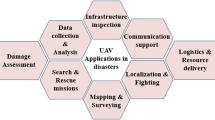Abstract
Recently, broadcast communications in mobile ad hoc networks (MANETs) have been deployed in many mission-critical applications. So far, most investigations of such broadcast networks focus on multi-hop connectivity taking all one-hop links for granted. In this paper, the reliability and performance of real-time one-hop broadcast services in IEEE 802.11 based MANETs are investigated analytically and by simulation. Having specified possible applications and the features of IEEE 802.11 broadcast communication in dynamically self-organized networks under harsh communication environment, analyses are conducted to derive closed form expressions of the reliability and performance indices for both one-dimensional (1-D) and two-dimensional (2-D) broadcast MANETs: packet reception rate (PRR) and packet transmission delay. The proposed analytical models account for the impact of broadcast hidden terminal problem, message arrival interval, backoff counter process, space distributions of nodes, and fading transmission channel on the reliability and performance of the broadcast MANETs. As an example, the proposed models are applied to the evaluation of safety-related inter-vehicle communication on a highway. From the obtained numerical results under various offered traffic and network parameters, new observations and effective enhancement suggestions are given.















Similar content being viewed by others
References
Standard Specification for Telecommunications and Information Exchange Roadside and Vehicle Systems-5 GHz Band Dedicated Short Range Communications (DSRC) Medium Access Control (MAC) and Physical Layer (PHY) Specifications ASTM E2213-03, Sep. 2003.
Moreno, M. T., Jiang, D., & Hartenstein, H. (2004). Broadcast reception rates and effects of priority access in 802.11-based vehiclar ad-hoc networks. In ACM international workshop on vehicular ad hoc networks (VANET’04) (pp. 10–18). Philadelphia, Pennsylvania.
Xu, Q., Mak, T., & Sengupta, R. (2004). Vehicle-to-vehicle safety messaging in DSRC. In ACM international workshop on vehicular ad hoc networks (VANET’04) (pp. 19–28). Philadelphia, Pennsylvania.
DARPA. Army collaborative future combat system FCS. http://www.darpa.mil/fcs.
Betts, B. J., Mah, R. W., Papasin, R., Mundo, R. D., Mcintosh, D. M., & Jorgensen, C. (2005). Improving situation awarness for first responders via mobile computing. Tech. Rep. NASA/TM-2005-213470, 2005.
Tang, K., & Gerla, M. (2000). MAC layer bradcast support in 802.11 wireless networks. In IEEE military communications conference (MILCOM).
IEEE 802.11 Working Group, Part 11: wireless LAN medium access control (MAC) and physical layer (PHY) specifications, ANSI/IEEE Std. 802.11, Sept. 1999.
Cheng, Y.-C., & Robertazzi, T. G. (1989). Critical connectivity phenomena in multihop radio models. IEEE Transaction on Communication, 37(7), 770–777.
Philips, T. K., Panwar, S. S., & Tantawi, A. N. (1989). Connectivity properties of a packet radio network model. IEEE Transaction on Information Theory, 35(5), 1044–1047.
Piret, P. (1991). On the connectivity of radio networks. IEEE Transaction on Information Theory, 37(5), 1490–1492.
Yousefi, S., Altman, E., El-Azouzi, R., & Fathy, M. (2008). Analytical model for connectivity in vehicular ad hoc networks. IEEE Transaction on Vehicular Technology, 57(6), Nov. 2008.
Moreno, M. T., Corroy, S., & Hartenstein, H. (2004). IEEE 802.11-based one-hop broadcast Communications: Understanding transmission success and failure under different radio propagation environments. In ACM international workshop on modeling analysis and simulation of wireless and mobile systems (MSWiM’06) (pp. 68–77). Torremolinos, Malaga, Spain.
Sibecas, S., Corral, C. A., Emami, S., & Stratis, G. (2002). On the suitability of 802.11a/RA for highway-mobility DSRC. In IEEE 55th vehicle technology conference (pp. 229–234). Birmingham, Alabama, Spring.
Li, X., Nguyen, T. D., & Martin, R. P. (2004). An analytic model predicting the optimal range for maximizing 1-hop broadcast coverage in dense wireless networks. In Proceedings of the 3rd international conferences on ad-hoc networks & wireless (pp. 172–182). Vancouver, Canada, July 2004.
Choi, J., So, J., & Ko, Y. (2005). Numerical analysis of IEEE 802.11 broadcast scheme in multihop wireless ad hoc networks. In The 19th international conference on information networking (pp. 1–10).
Fracchia, R., & Meo, M. (2008). Analysis and design of warning delivery service in intervehicular networks. IEEE Transaction on Mobile Computing, 7(7), July 2008.
Oliveira, R., Bernardoand, L., & Pinto, P. (2009). The influence of broadcast traffic on IEEE 802.11 DCF networks. Computer Communications (Elsevier), 32(2), 439–452.
Ma, X., Chen, X., & Refai, H. (2008). On the broadcast packet reception rates in one-dimensional MANETs. IEEE GLOBECOM, Nov. 30–Dec. 4, New Orleans, 2008.
Andrews, J. G., Ganti, R. K., Haenggi, M., Jindal, N., & Weber, S. (2010). A primer on spatial modeling and analysis in wireless networks. IEEE Communications Magazine, 48(11), 156–163.
Trivedi, K. S. (2002). Probability and statistics with reliability, queuing and computer science applications (2nd ed.). New Jersey: Wiley.
Farhadi, G., & Beaulieu, N. C. (2006). Connectivity and bit error rate analysis of mobile ad hoc wireless networks. In IEEE 64th Vehicle Technology Conference, Fall.
Ma, X., Chen, X., & Refai, H. (2007). Unsaturated performance of IEEE 802.11 broadcast service in vehicle-to-vehicle networks. In IEEE vehicular technology conference, Fall 2007.
Zhai, H., Kwon, Y., & Fang, Y. (2004). Performance analysis of IEEE 802.11 MAC protocols in Wireless LANs. Wireless Commun Mobile Comput, 4, 917–931.
Zheng, Y., Lu, K., Wu, D., & Fang, Y. (2006). Performance analysis of IEEE 802.11 DCF in imperfect channels. IEEE Transaction on Vehiclar Technology, 55(5), Sept. 2006.
Ma, X., & Chen, X. (2007). Saturation Performance of the IEEE 802.11 broadcast networks. IEEE Communication on Letters, 11(8).
Li, X., & Zeng, Q.-A. (2007). Influence of bit error rate on the performance of IEEE 802.11 MAC protocol. In IEEE wireless communications and networking conference, March 2007.
Author information
Authors and Affiliations
Corresponding author
Rights and permissions
About this article
Cite this article
Ma, X. On the reliability and performance of real-time one-hop broadcast MANETs. Wireless Netw 17, 1323–1337 (2011). https://doi.org/10.1007/s11276-011-0351-x
Published:
Issue Date:
DOI: https://doi.org/10.1007/s11276-011-0351-x




